Biology
Biology concepts ? protists, complexity, undulipodia, flagella, cilia, amoebas,
Are humans the most complex animals? Humans have cells, tissues, organs, and organ systems that allow us to do things that no other organism can do ? like invent doughnuts.
We start with the Phylum Actinopoda ? their pictures are very impressive. No, I don?t mean that they are good photographers. Seeing them shows you how delicate and complex they are. The have silica (glass-like) coverings that protect them from the outside world. Though many of these organisms are among the zooplankton(zoo = animal-like, and plankton = drifter) that are in the oceans; remember that plankton don?t have to be microorganisms; many species of jellyfish are zooplanktonic as well.
While radiolarian zooplantokton skeletons are responsible for a lot of the sediment at the bottom of the ocean and over time ? forming rock called radiolarite, the tests of foraminifera organisms go to form limestone and chalk.
Amoeboflagelleates are the exception, and can switch back and forth from amoeba form to flagellated form, depending on their environment. When in a liquid environment, amoeboflagellates use flagella to move about. But when in dry environment or a surface, the resorb their undulipodia and move by amoeboid mechanism. One amoeboflagellate in particular gets my attention.
Phylum Sarcomastigophora ? this group of protists includes the most animal-like organisms that aren?t officially animals. The trichonympha have over 1000 flagella, but more species are like the choanoflagellates (means collared flagellar cells). These are believed to be the ancestor of all animal cells. They are very similar to the choanocytes of sponges, the most basal of the animals. However, a 2014 study warns against assuming that they are the same. The bending of the modified cilium that marks the choanocyte functions differently in the protists as compared to the sponges. The two diverged more than 600 million years ago, so similarities are there, but so are differences.
Some modified cilia funnel food into an oral groove, something that looks supiciously like a mouth to you and me. This is just the start of how they look like animals, they also get rid of waste in just one place, like our backside.
Balantidiasis is characterized by explosive diarrhea, as much as one explosion every 20 minutes. Don?t think that "explosion" is too extreme a word. In some cases, the colon can literally have a hole blown in it (perforated) by the action of this ciliate. All that is bad enough, but a 2013 case study showed that B. coli infected an immunocompetent man?s spine, led to a pinching of the cervical nerves, and caused a temporary quadriplegia! Ciliates are complex, yes ? and apparently one of them is mean.
Jack, R., Garrod, O., & Schyns, P. (2014). Dynamic Facial Expressions of Emotion Transmit an Evolving Hierarchy of Signals over Time Current Biology, 24 (2), 187-192 DOI: 10.1016/j.cub.2013.11.064
Dhawan S, Jain D, & Mehta VS (2013). Balantidium coli: an unrecognized cause of vertebral osteomyelitis and myelopathy. Journal of neurosurgery. Spine, 18 (3), 310-3 PMID: 23259539
Chou J, Hao J, Kuroda S, Ben-Nissan B, Milthopre B, & Otsuka M (2014). Bone regeneration of calvarial defect using marine calcareous-derived beta-tricalcium phosphate macrospheres. Journal of tissue engineering, 5 PMID: 24808939
Yuasa T, & Takahashi O (2014). Ultrastructural morphology of the reproductive swarmers of Sphaerozoum punctatum (Huxley) from the East China Sea. European journal of protistology, 50 (2), 194-204 PMID: 24447698
Sifuentes LY, Choate BL, Gerba CP, & Bright KR (2014). The occurrence of Naegleria fowleri in recreational waters in Arizona. Journal of environmental science and health. Part A, Toxic/hazardous substances & environmental engineering, 49 (11), 1322-30 PMID: 24967566
Mah JL, Christensen-Dalsgaard KK, & Leys SP (2014). Choanoflagellate and choanocyte collar-flagellar systems and the assumption of homology. Evolution & development, 16 (1), 25-37 PMID: 24393465
- Prokaryotes Versus Eukaryotes
Cell Webquest ? Ms. Carter Prokaryotes versus Eukaryotes California Standard: Cell Biology 1. c Cell Biology: The fundamental life processes of plants and animals depend on a variety of chemical reactions that occur in specialized areas of the organism?s...
- Cell Organelles In Eukaryotes
Name of the cell organelle Functions 1. Cell wall (Absent in animals and some protists. Present in bacteria, fungi, algae and plants). - Gives rigidity and support to the tissues and organs. Gives characteristic...
- Crawling To The Top
Biology concepts ? characteristics of animals, undulipodia, gametes, nematodes, roundworms, Yes, a sponge is an animal ? just like a barracuda, a platypus or a that weird nephew of yours. They are multicellular, loosely organized into a couple tissues,...
- The Fungus And The Frog
Biology concepts ? common descent, evolution, direct descent, fungi, undulipodia, amphibians, phylogenetics THIS IS NOT HOW EVOLUTION OCCURS!! What this animation implies is that one type of animal became another type of animal. It shows a chimp becoming...
- A Tale Of Two Tails
Biology concepts ? flagella, bacteria, prokaryotes, eukaryotes, undulipodia, axoneme, basal body, centriole Everyone has the dream where you show up for a class that you didn?t know was on your schedule, only to be having a test. But in second place...
Biology
Doing More With Less
Biology concepts ? protists, complexity, undulipodia, flagella, cilia, amoebas,
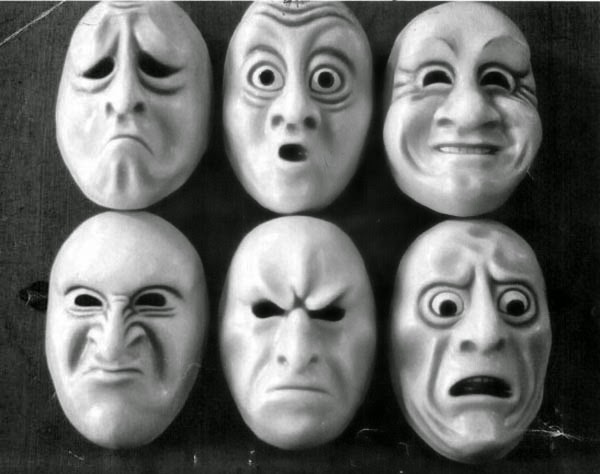 |
| Emotions are one of the things that make humans so complex. Memories attached to associations, stimulated by individualized brain chemistry makes it so you can?t predict how any one person might feel about a particular stimulus. But perhaps we are not so complex. A new study suggests that there are really only four human emotions, happy, sad, afraid, and mad. The other two commonly held states, disgusted and surprised are just sides of mad and afraid, respectively. Read the study and feel?? something. |
Indeed, this makes us complex and hard to understand, especially when we mumble. But on the other hand, wouldn?t it be more amazing if an organism could do complex things withoutthe benefit of all that organization and without all those trillions of cells doing different jobs?
What if an organism did many complex things but was only made of one cell? I think this blog has shown on many occasions that bacteria are capable of some pretty astounding feats, and they don?t even have a nucleus! True, they don?t have structures as complex as ours, most of their behaviors are responses to chemical signals from other cells, and they can?t make doughnuts.
But there are other single celled organisms that might match us for complexity, or even exceed our level of complexity, and they do it all within the confines of a single cell. Of course I?m talking about the ciliate protists. If don't know them, stick around and meet them and their kin. Sometimes, less is more.
We have been talking about the undulipodia in the last few weeks, and our last story started to describe the great catch-all kingdom, the protists. They use cilia and eukaryotic flagella (these being the undulupodia), but this is just one characteristic that can be used to separate them into groups.
The last post talked about the plant-like protists and how they can use flagella to either move around or to have their gamete cells move around. Today let?s discuss the animal-like protists; they use undulipodia in more ways.
There are six phylums of animal-like protists, just like there were six phylums of plant-like protists ? but I think that was just a happy accident. The animal-like protists have more diversity amongst their phyla than did the plant-like protists; some use flagella, some use cilia, some use neither. Each phylum is amazing, but we?ll save the most complex ? or is that most simple ? for last.
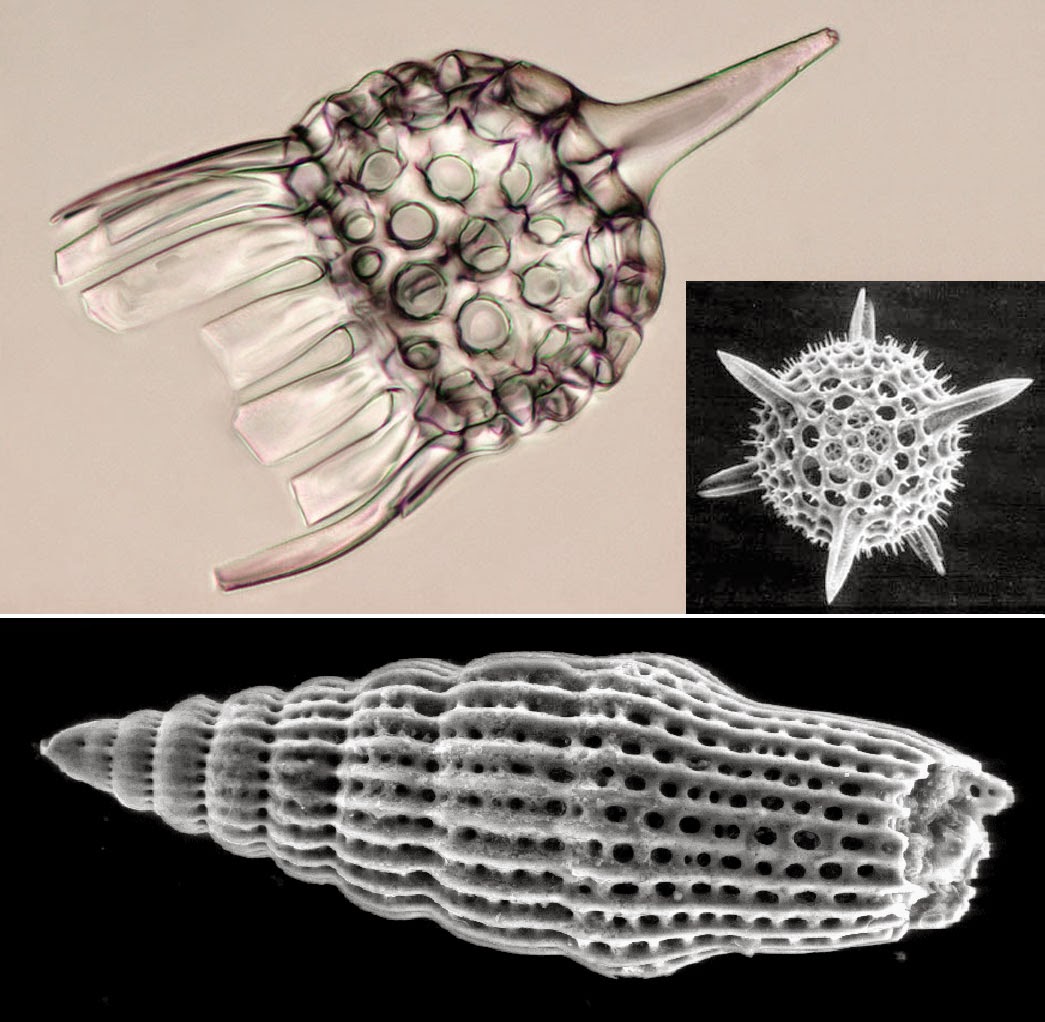 |
| The radiolaria are counted amongst the actinopoda. They have intricate mineral skeletons. What you can?t appreciate from these photomicrographs is that also have an inner skeleton that divides them into an endoplasm and ectoplasm. Some house algae in there ectoplasm to harvest their photosynthetically- produced carbohydrates. |
The radiolaria are amongst the actinopoda and are quite complex. They're one celled, but the cell has two parts, an endoplasm that contains the nucleus and organelles, and the ectoplasm, that has frothy bubbles to control their buoyancy.
Radiolaria are floaters, which would suggest that they don?t use undulipodia for motility. In fact, the only time that flagella have been observed in radiolarians is in some swarmer cells. Scientists think these represent sexual reproductive gametes that might be released from a swelling in the adult cell. Sexual reproduction has not been confirmed; scientists must be too embarrassed to ask them about it.
The swarmers are very small, as a new study shows and can move in the water column. This may be why we often find radiolarian DNA at depths where they don?t live ? it?s their swarmers. And they do seem to get around. A Russian cosmonaut just reported having sampled the windows on the space station and found plankton! They think they have escaped the atmosphere on the wind. If true, that certainly changes our post about life moving from Earth to space.
Phylum Foraminifera ? these organisms have tests, shells of calcium carbonate with little holes in them from which they stick out a pseudopod (we'll see more of this below) and walk. The foarminifera look like and are closely related to the actinopoda. Some wonder if they shouldn?t be lumped together, but we all know that arguments about protist classification are the rule, not the exception. Like actinopoda, they only show flagella on their gametes, and like actinopoda, the gametes are biflagellated.
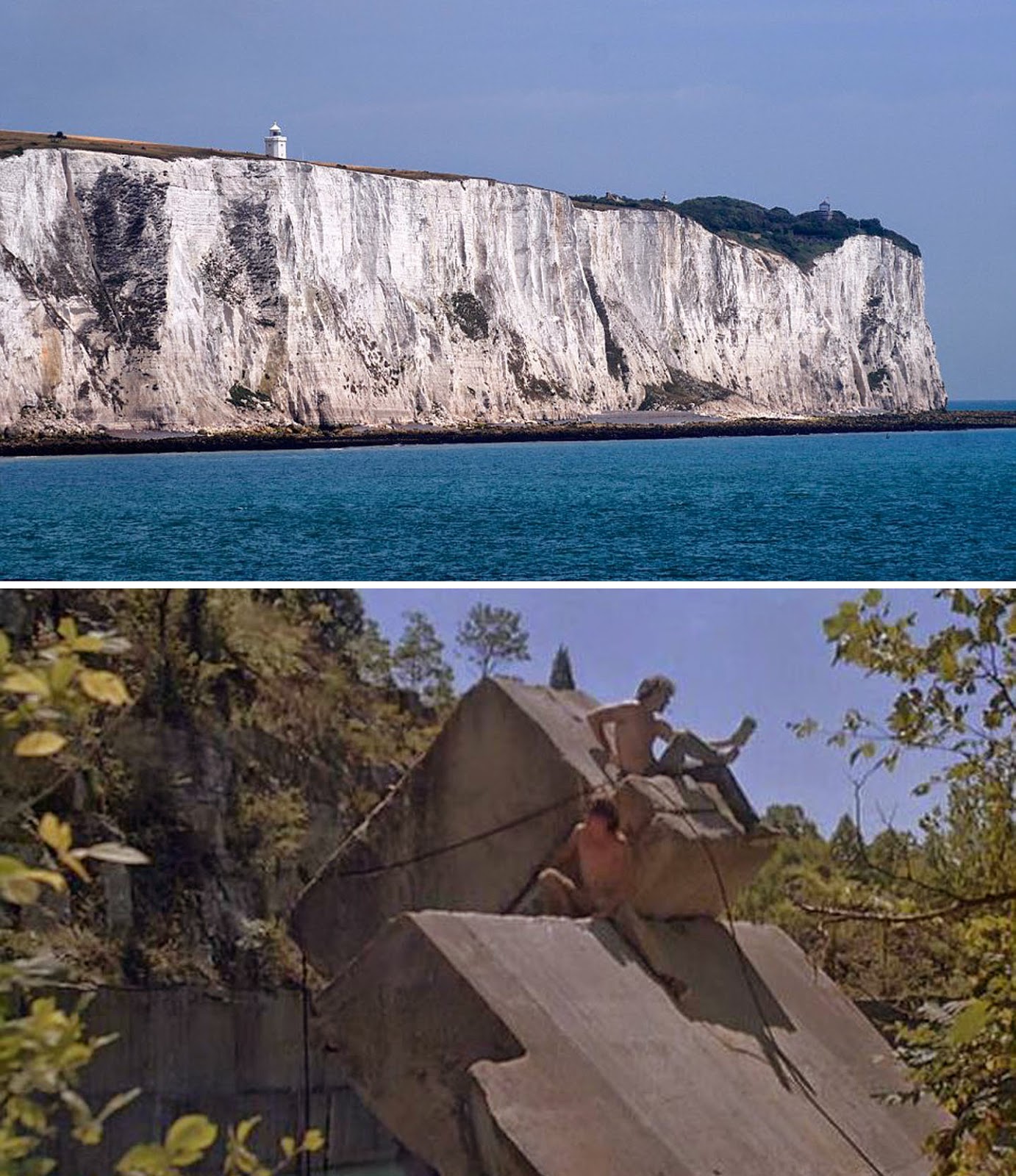 |
| The foraminifera are protists with calcium carbonate shells. I wonder if the RAF pilots returning during WWII knew that the White Cliffs of Dover are chalk formed from these protists. Likewise, the limestone quarries in Bloomington, IN where they filmed Breaking Away in 1979 are also made from the tests of these protists. |
Oil spills and other such disasters are having an effect on the ability of foraminifera to maintain their calcium tests, and this affects us beyond just having some pretty cliffs to look at. We may be using foraminifera in the future to repair bone injuries.
A 2014 study showed that using foraminifera exoskeletons is a good way to promote bone growth in skull defects in rats. The hope is that we can use these for bone grafts and for bone repair in the future. As long as we don?t destroy all the formanifera.
Phylum Apicomplexa ? We could talk about the best known apicomplexans for years and just touch the surface of their biology. Why do we know so much about them? Because they kill us. Plasmodium falciparum is an apicomplexan ? it causes malaria. Toxoplasma gondiiis an apicomplexan; it causes toxoplasmosis that can chew holes in your brain and kill you as well.
Apicomplexans are immotile, a lot like the planktonic foraminifera and actinopoda. But in this case they're usually carried around from place to place inside a living host. The vast majority of them are parasites. Since they get carried around, they don?t need flagella to move, but some of the species have gametes that have three flagella on their back ends. Even though I?m breaking my parasitology friend Bill?s heart, I am going to leave the apicomplexa here and move on. Don?t worry Bill, we?ll come back to them soon.
Phylum Rhizopoda - These are the amoebas; most don?t have cilia or flagella. They move by pseudopodia (pseudo = false, podia = feet), oozing their membrane and cytoplasm in one direction and then pulling the rest along. Of course, this means they need a surface to move across, you don?t use pseudopodia to move in water. But this phylum also includes the ameoboflagellates,
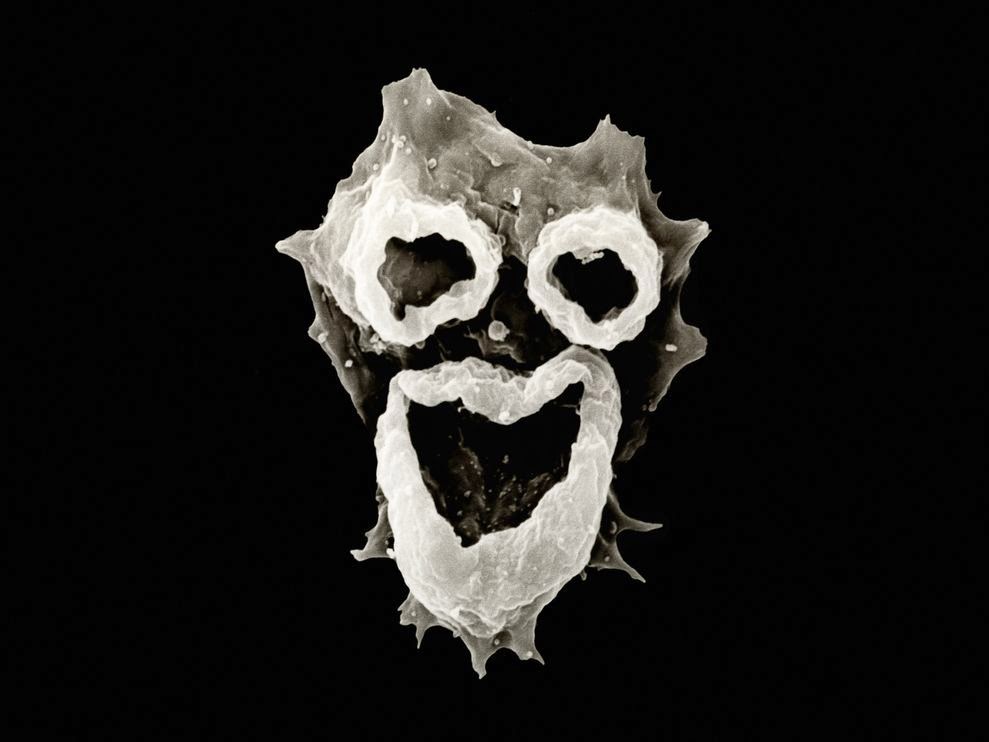 |
| Naegleria fowleri lives in warm waters. It enters the body through the nose and travels straight to the brain. The feeding structures look like a clown face, which makes it double frightening for my daughter. The infection is almost always fatal. Must be a sad clown. |
Naegleria fowleriis the brain-eating protozoan that is transmitted through contaminated drinking or swimming water. It may not happen often, but I hate to think about something swimming (or would they crawl?) around my brain and feasting. Primary amoebic meningioencephalitis from N. fowleriis fatal in about 95% of cases, and though it is rare worldwide, most cases occur in the U.S.
A 2014 study in Arizona found that N. fowleri in five of 33 lakes studied. That?s scary enough, but the researchers also found that the protozoa were present in the cooler months, when it had been supposed that the cooler water temperatures were lethal to the organism. I am not retiring to Arizona.
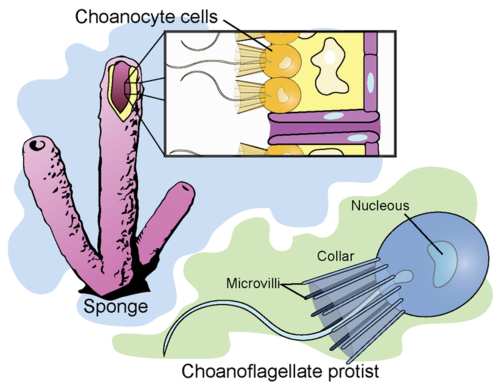 |
| Choanoflagellates look so much like the choanocyte cell type in sponges. They are both collared and have a flagellum sticking out. Since sponges are the basal phylum of kingdom Animalia, it is believed that choanocyte protists are the ancestor to all animal cells. But a new study says don?t be so hasty. They resemble each other, but it could be parallel evolution not straight descent. |
Phylum Ciliophora ? The ciliates are those ?less is more? organisms we described at the beginning of this post. These organisms have cilia all over their bodies, and they use them for feeding, motility (swimming and crawling), attachment and for sensing chemicals and perhaps sensing mates. These are all very complex behaviors for single-celled organisms. But wait, they do more.
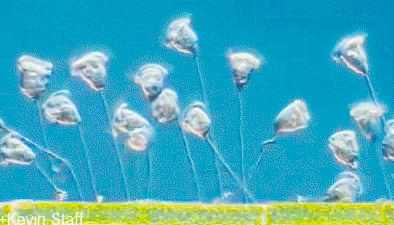 |
| Vorticella is one of the ciliates. It uses it?s cilia to shovel prey into its oral groove, but the adult doesn?t use cilia to move. They anchor to one spot and duck predators. The myoneme doesn?t spring them up, it coils them down when something tries to eat them. |
They have a complex cytoskeleton, made of connections between all those cilia. They have contractile vacuoles that control their water content. They even carry spears called trichocysts for defense against predators. These are like the cnidocytes of the jellyfish, and are a trick that we, with all our complexity, can't come close to matching
So do they go beyond us, even though they only have one cell? Yep, you have seen anything yet. Ciliates have up to six life cycle stages, they all have two nuclei, and they go through an insanely complex sexual reproduction that uses seven different sexes ? with all our complexity, we only manage two - or are there more? That could be a good series of posts as well.
Ciliates are free living and cause us no problem. But in a great show of disrespect to their inferiors, Balantidium coli can be a horrible problem for us. It's the exception among ciliates in that it causes a disease, Balantidiasis, in primates. The organism usually lives in the guts of pigs, but if it gets into our gut, and we then become immunocompromised ? watch out.
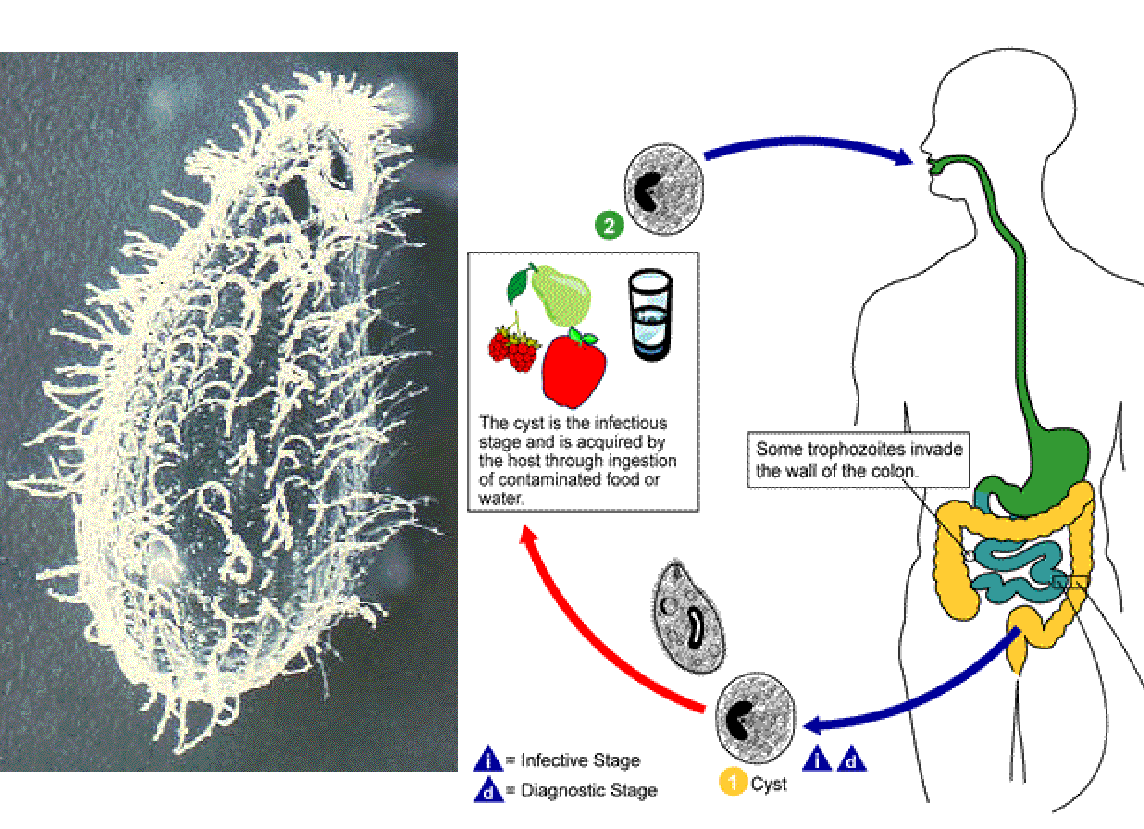 |
| This is B. coli, the only know ciliate to cause disease in mammals. You see all the cilia, that is how it moves around. It is transmitted via the oral-fecal route, but might also be transmitted by undercooked pork. Some people say fecal-oral, but that sounds more gross to me. |
We haven?t talked about the fungus-like protists. We?ll include them when we talka bout the undulipodia of the plants and fungi. Some plants cells have flagella for movement. Is my salad going to crawl off my plate?
But next week we'll start some Thanksgiving posts. Should we really be eating goat for Thanksgiving?
But next week we'll start some Thanksgiving posts. Should we really be eating goat for Thanksgiving?
For more information or classroom activities, see:
Plankton ?
https://www.ted.com/talks/the_secret_life_of_plankton
http://www.planktonchronicles.org/en
http://teachoceanscience.net/teaching_resources/education_modules/plankton_-_aquatic_drifters/get_started/
http://earthref.org/SCC/activities.htm
http://www.google.com/url?sa=t&rct=j&q=&esrc=s&source=web&cd=1&ved=0CB4QFjAA&url=http%3A%2F%2Fwww.msc.ucla.edu%2Foceanglobe%2Fpdf%2FPlanktonPDFs%2FPlanktonEntirePackage.pdf&ei=ealPVMqnAZCLyAT824H4CA&usg=AFQjCNHUdz6d1tbModFaA5xipJfEKU5FFg&sig2=-B_NAOH3gwPJge4NFj82EQ&bvm=bv.77880786,d.aWw
http://www.google.com/url?sa=t&rct=j&q=&esrc=s&source=web&cd=4&ved=0CC8QFjAD&url=http%3A%2F%2Fwww.marine.usf.edu%2Fpjocean%2Fpackets%2Ff01%2Ff01u6p2.pdf&ei=26lPVP2oBYSoyQS24oKQBg&usg=AFQjCNFQIY8_kJNt-aupbz3M2vNbeM-Mdw&sig2=-45SZ7wU2-Rf43Iwfc-d2Q&bvm=bv.77880786,d.aWw
http://www.ucmp.berkeley.edu/fosrec/Olson2.html
http://www.google.com/url?sa=t&rct=j&q=&esrc=s&source=web&cd=14&ved=0CGAQFjAN&url=http%3A%2F%2Fwww.cosee.net%2Fbest_activities%2Factivity%2FThe_Great_Plankton_Race.pdf&ei=26lPVP2oBYSoyQS24oKQBg&usg=AFQjCNH9-KmfGDfr8qpJo9L5zMYpaDIsQg&sig2=FDh3sBbfvLkklA0Rcu7Evw&bvm=bv.77880786,d.aWw
http://www2.vims.edu/bridge/search/bridge1output_menu.cfm?q=plankton
http://education.nationalgeographic.com/education/activity/save-the-plankton-breathe-freely/?ar_a=1
http://askabiologist.asu.edu/experiments/sketch-plankton/for-teachers
http://www.google.com/url?sa=t&rct=j&q=&esrc=s&source=web&cd=22&ved=0CCMQFjABOBQ&url=http%3A%2F%2Faskabiologist.asu.edu%2Fsites%2Fdefault%2Ffiles%2Fresources%2Factivities%2Fplankton%2Fplankton_eat_plankton_packet5.pdf&ei=dKpPVKnCL4eAygTsp4HwCg&usg=AFQjCNEZVA7NTwwdyyoVEhbqCbZs_nQpyw&sig2=0pWaPsI0K9552707yqu9BA&bvm=bv.77880786,d.aWw
http://blog.baybackpack.com/?p=1771
http://www.planktoninvasion.com/en/
http://oceanservice.noaa.gov/facts/phyto.html
N. fowleri ?
http://www.scientificamerican.com/article/what-happens-when-an-amoeba-eats-your-brain/
http://news.nationalgeographic.com/news/2013/13/130814-amoeba-brain-naegleriafowleri-infection-parasite/
http://www.ucmp.berkeley.edu/protista/apicomplexa.html
http://www.cdc.gov/parasites/naegleria/
http://www.webmd.com/brain/brain-eating-amoeba
http://www.livescience.com/38897-how-to-survive-a-brain-eating-amoeba.html
http://www.techtimes.com/articles/10355/20140712/naegleria-fowleri-rare-brain-eating-amoeba-kills-9-year-old-kansas-girl.htm
http://www.techtimes.com/articles/10355/20140712/naegleria-fowleri-rare-brain-eating-amoeba-kills-9-year-old-kansas-girl.htm
http://www.animalplanet.com/tv-shows/monsters-inside-me/videos/the-brain-eating-amoeba.htm
Ciliates ?
http://www.ucmp.berkeley.edu/protista/ciliata.html
http://cfb.unh.edu/phycokey/Choices/Amoebae_Flagellates_Ciliates/Ciliates/ciliates_key.htm
http://www.sciencefriday.com/blogs/01/03/2012/microorganisms-on-the-move.html
http://www.microscopy-uk.org.uk/mag/indexmag.html?http://www.microscopy-uk.org.uk/mag/wimsmall/cilidr.html
http://users.rcn.com/jkimball.ma.ultranet/BiologyPages/C/Ciliates.html
http://www.micrographia.com/specbiol/protis/cili/cili0100.htm
http://protozoa.uga.edu/portal/ciliated_protozoa.html
http://www.microscope-microscope.org/applications/pond-critters/protozoans/ciliphora/ciliophora.htm
http://www.photobiology.info/LenciCiliates.html
http://www.environmentalleverage.com/Stalkedciliates.htm
http://www.environmentalleverage.com/Stalkedciliates.htm
http://www3.wooster.edu/biology/Ciliates/Ciliates_in_the_Classroom.html
http://www.ncbi.nlm.nih.gov/pmc/articles/PMC3587665/
- Prokaryotes Versus Eukaryotes
Cell Webquest ? Ms. Carter Prokaryotes versus Eukaryotes California Standard: Cell Biology 1. c Cell Biology: The fundamental life processes of plants and animals depend on a variety of chemical reactions that occur in specialized areas of the organism?s...
- Cell Organelles In Eukaryotes
Name of the cell organelle Functions 1. Cell wall (Absent in animals and some protists. Present in bacteria, fungi, algae and plants). - Gives rigidity and support to the tissues and organs. Gives characteristic...
- Crawling To The Top
Biology concepts ? characteristics of animals, undulipodia, gametes, nematodes, roundworms, Yes, a sponge is an animal ? just like a barracuda, a platypus or a that weird nephew of yours. They are multicellular, loosely organized into a couple tissues,...
- The Fungus And The Frog
Biology concepts ? common descent, evolution, direct descent, fungi, undulipodia, amphibians, phylogenetics THIS IS NOT HOW EVOLUTION OCCURS!! What this animation implies is that one type of animal became another type of animal. It shows a chimp becoming...
- A Tale Of Two Tails
Biology concepts ? flagella, bacteria, prokaryotes, eukaryotes, undulipodia, axoneme, basal body, centriole Everyone has the dream where you show up for a class that you didn?t know was on your schedule, only to be having a test. But in second place...
